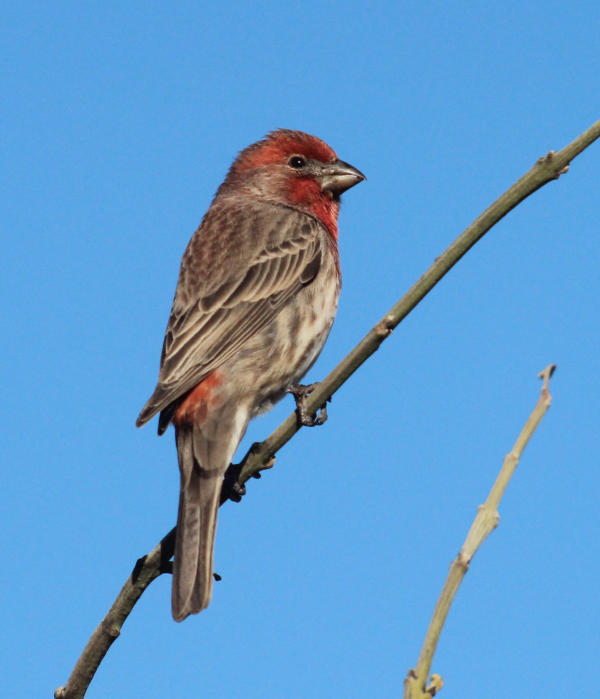
House Finch male

House Finch female
|
House Finches are one of the most common birds at feeders and in the field across the United States, but their distribution and ecology have been dramatically altered by people. Historically a bird of dry habitats in Mexico and the American Southwest, these colorful finches were popular with pet dealers who marketed them as “Hollywood Finches” in the early 1900s.
To avoid prosecution under the Migratory Bird Treaty Act, which protects wild birds, bird sellers on Long Island, New York, liberated their House Finches during the 1940’s. The rest, as they say, is history. From this humble beginning, House Finch populations exploded and the species progressively expanded their range across the country from east to west and north to south until they merged with the original western population.
Today, House Finches are conspicuous in most neighborhoods. They consume sunflower, safflower and nyjer seeds at feeders and sometimes nest in hanging planters and other structures in our yards. They are one of few birds that feed their offspring on plant foods only, primarily regurgitated seeds. Most seed-eating birds feed insects to their nestlings as a protein source.
House Finches are susceptible to an eye disease called avian conjunctivitis, which causes their eyes to become red, runny and swollen. First recorded in Maryland in 1994, the bacterium may cause the finch’s eyes to swell shut, resulting in blindness. Some birds recover, but most die from starvation or predation.
If you have House Finches at your feeder, sooner or later you’ll see a male that is colored more orange or yellow than red. This is a case of “you are what you eat.” Red, orange and yellow colors in birds come from ingested pigments, called carotenoids, in the bird’s diet. So that orange- or yellow-tinted male House Finch actually has been consuming something that changed the color of its feathers.
Range: House Finches are residents across most of their range, but some northern and eastern birds migrate. They range from southern Canada to southern Mexico and across the United States.
Habitats: In the West, House Finches inhabit open dry areas and woodland borders, but throughout their range they favor urban habitats. They are less likely to be found in expanses of forests or grasslands.
Mating: Form pairs during winter and may stay together year-round. Males display to females using a flight-song display that includes song, slow fluttering wingbeats and graceful aerial dives. Males also hop near female while drooping wings, raising tail, and singing. Males may offer food to females during courtship.
Nest Sites: House Finches construct their nests on ledges of man-made structures and in coniferous and deciduous trees. They may build their nest on rock ledges and even cacti are used. Bowl-shaped nests are built with fine grasses and materials and lined with even finer, soft materials such as animal hair.
Clutch Size: 2 to 6 white to pale blue eggs, sometimes speckled. Some House Finches may nest more than once per season.
Incubation Period: 12 to 14 days. Nestlings are altricial and hatch featherless except for fine down along feather tracts, eyes closed and helpless, but grow quickly.
Fledging: 12 to 19 days.
Food: Predominantly plant materials such as weed seeds, fruits, flower parts and leaf buds.
Conservation: Abundant and increasing; “Least Conservation Concern.”